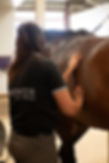Tel: 847-772-4719
What's In A Session?
Therapeutic Approach
Restorative Neuromuscular Bodywork allows me to converse with the horses to assess their posture and range, address restrictions, and reset tone. This is done having three cornerstones in mind: regulating the nervous system, bringing the body into homeostatic balance, and re-educating the mind-body connections. In between sessions, my clients are encouraged to support their horses with home strategies as bodywork is most successful when implemented cooperatively.

Emotional Regulation
Facilitating the horse’s connection to breath and ability to bring their nervous system into a parasympathetic state (rest, digest, relax, heal) is a conversation I start from the first contact. Every horse is in a different place with their ability to regulate their own nervous system, and guiding them to be able to achieve this for themselves is an important foundation to not just their session, but to optimal wellness. This starts with the breath and builds throughout the session as we achieve mental comfort when awareness is brought to the body.
Body Balancing
Throughout each session I assess bodily symmetry, posture, potential compensation patterns, range of motion, movement, and areas of tissue restriction. This is done through visual assessment (static and dynamic), palpation, observing behavioral and physiological responses to manual techniques as I work, as well as talking through your observations of them from the ground and feel in the saddle.
Manual soft tissue techniques are used to release fascial and muscular tension, address trigger points, relieve neural entrapment, and support lymphatic movement. Techniques include massage, sustained pressure, myofascial release, muscle scraping, and passive stretching.


Neuromuscular
Education
Many horses are true masters of what is referred to as “homuncular smudging”, where pain rewires the brain connection to the body in a way to protect itself from further pain. This can result, to name a few examples, in reduced awareness of a limb, altered/dysfunctional movements, and a feeling of disconnect; all of which can lead to drastic asymmetries, dysfunctional biomechanics, lameness, or further injury when compensation patterns transfer stress to different areas of the body.
Touch brings awareness to the somatosensory cortex to refresh these connections within the neuromuscular connection, as well as slow guided posturing and movement of the limbs, neck, head, tail, or trunk.
Ongoing
Advisement
Homework is a great way to support the important work started in each session, and often advise clients on emotional, therapeutic, groundwork, or under saddle exercises that help their horses (and themselves) maintain the optimal posture and healthy movement patterns to achieve their goals.
Recheck appointments are also essential to achieving results from bodywork, with 3-4 closely spaced appointments recommended before determining an individualized maintenance schedule.
